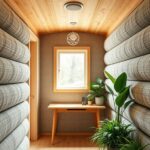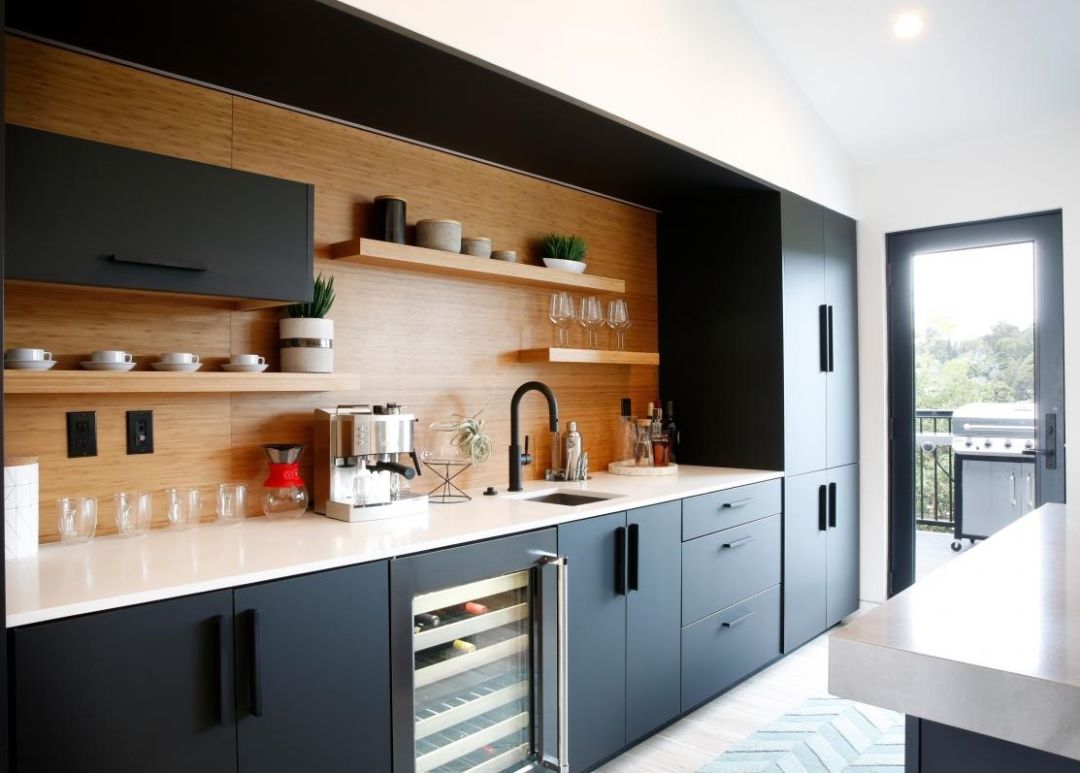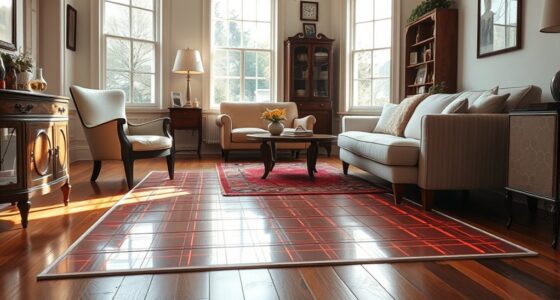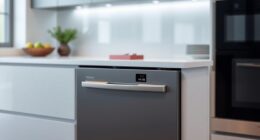To install daylighting tubes in windowless rooms, first assess your space and roof to find the best placement, avoiding obstructions. Measure and cut the roof opening carefully, sealing all gaps to prevent leaks. Connect the reflective tube and attach the dome to your ceiling, ensuring proper assembly. Seal all connections and follow building codes. This simple project can brighten your space naturally and efficiently — keep exploring for detailed steps and tips.
Key Takeaways
- Assess roof and ceiling to identify optimal placement, avoiding obstructions and ensuring proper alignment for effective light transmission.
- Choose between flexible or rigid tubes based on space constraints and installation complexity.
- Seal and waterproof all penetrations to prevent leaks and ensure durability.
- Use high-quality reflective materials like Spectralight Infinity for maximum light efficiency.
- Incorporate diffusers and interior surfaces to evenly distribute natural light and enhance room ambiance.
Understanding the Benefits of Daylighting Tubes for Windowless Spaces

Daylighting tubes offer a practical solution for bringing natural light into windowless spaces, making them brighter and more inviting. Thanks to their efficient light-gathering dome design, they deliver natural daylight comparable to larger windows or roof lights. These systems channel sunlight directly from the roof into interior rooms, creating a vibrant and warm atmosphere. Natural light from daylighting tubes reveals true colors and enhances the room’s overall ambiance, especially in areas like bathrooms, hallways, and closets that usually rely on artificial lighting. Plus, they avoid the heat gain issues common with traditional skylights or large windows, maintaining comfortable indoor temperatures. This means you enjoy the benefits of natural light without sacrificing energy efficiency or comfort, making your space more pleasant and inviting every day. Additionally, the use of high-quality projectors in home theaters can further enhance your viewing experience by providing sharp, vivid images that complement the natural illumination.
Choosing the Right Type of Daylighting Tube for Your Needs

Selecting the appropriate type of daylighting tube depends on your specific needs, space constraints, and installation environment. If you have limited space or need flexibility, flexible tubes may be your best option, while rigid tubes suit larger, straightforward installations. Consider the materials: high-quality reflective options like Spectralight Infinity can transmit up to 99.7% of light, maximizing efficiency. For capturing sunlight, choose domes made from durable, UV-resistant polycarbonate or acrylic, especially in harsh weather areas where hail-resistant domes are beneficial. Budget also matters; basic solar tubes typically cost between $150 and $300, offering a cost-effective solution. Think about your aesthetic preferences too—sleek or frameless designs can seamlessly blend into your space. Matching the tube type with your specific requirements ensures ideal performance and value. Proper installation and maintenance are essential to ensure long-term performance and prevent leaks. Additionally, understanding market research can help you select the most effective product based on current trends and customer feedback.
Step-by-Step Process of Installing Daylighting Tubes

Installing daylighting tubes requires careful planning and precise execution to guarantee peak performance. First, assess the room and roof to identify the best placement for the tube, avoiding obstructions like pipes or cables. Verify the ceiling point aligns with the roof flashing location, and determine the necessary hole size based on product specifications. Mark the roof spot directly above the chosen ceiling area, then cut the roof carefully, avoiding rafters. Remove shingles around the hole and seal the area with roofing sealant. Install the roof flashing securely, sealing it thoroughly. Assemble the tube sections, connecting the roof dome to the ceiling diffuser with adapters as needed. Insert the tube into the roof flashing and connect it to the diffuser, ensuring proper alignment and secure fittings. Proper sealing and waterproofing are essential to prevent leaks and ensure the longevity of the daylighting system. Additionally, it’s important to consider building codes and regulations to maintain safety and compliance throughout the installation process.
Enhancing Interior Design and Functionality With Natural Light

Once you’ve installed your daylighting tubes, you can begin to see how they transform your interior space. They boost aesthetic appeal by providing soft, diffused light that reduces harsh shadows and creates a welcoming atmosphere. You can integrate these systems into design features like light wells or luminous walls, offering flexibility to enhance your space’s look. The reflective interior surfaces minimize glare, ensuring consistent, comfortable lighting. Plus, they screen out UV and infrared rays, protecting furniture and finishes from fading or overheating. Natural light from these tubes can highlight focal points or add excitement to otherwise plain areas. They are considered the most modern method for natural light entry, helping you craft a visually appealing, functional environment that feels brighter, more inviting, and better suited to your design goals. Incorporating natural materials, such as wood or linen, can further enhance the cozy farmhouse ambiance in your space.
Environmental and Energy Advantages of Using Daylighting Solutions

Using daylighting solutions like tubes offers significant environmental and energy benefits that can transform your building’s sustainability profile. By reducing reliance on electric lighting, you can cut annual energy costs by around 40%, as seen in projects like LEED-certified dealerships. Over 90% of your floor space can be illuminated naturally, drastically lowering electricity use. Replacing electrical lighting with solar tubes also reduces your carbon footprint by decreasing fossil-fuel reliance. Longer-lasting than conventional bulbs, daylight tubes generate less waste and support green building standards like LEED Gold and Platinum. They harness free, renewable sunlight, conserving nonrenewable resources. Additionally, integrating daylighting in commercial spaces can lower HVAC loads and boost occupant comfort, further enhancing your building’s energy performance and sustainability. Embracing sustainable building practices can amplify these environmental advantages even further.
Frequently Asked Questions
Can Daylighting Tubes Be Installed on All Roof Types?
You wonder if daylighting tubes can be installed on all roof types. While they’re highly versatile, they’re best suited for roofs with slopes between 15 and 60 degrees. They work on shingle, tile, and metal roofs, and with specialized flashings, they can fit many roof materials. However, flat roofs are less common, so you’ll want to consult a professional to verify compatibility with your specific roof type.
How Long Do Daylighting Tubes Typically Last?
You wonder how long daylighting tubes last, right? Think of them as the steady heartbeat of your space, providing years of natural glow. Usually, they shine brightly for over 20 years with proper care. Regular cleaning and inspections keep them in top shape, like tending a garden. Quality installation and strong materials make them resilient against weather and wear, ensuring your room stays bright and inviting for decades to come.
Are There Maintenance Requirements for Daylighting Tubes?
You might wonder if daylighting tubes need regular maintenance. Generally, these systems are designed to be low-maintenance, with sealed domes and passive technology that reduces dirt and debris buildup. You should clean the exterior dome and diffuser every six months using mild soap and water to maintain ideal light transmission. Regular visual inspections help ensure seals stay intact and no debris blocks the light, but overall, these tubes require minimal upkeep.
Do Daylighting Tubes Affect Roof Warranty?
You might worry that installing daylighting tubes will void your roof warranty, but it’s often avoidable. When installed correctly with proper flashing and by experienced professionals, daylighting tubes typically won’t harm your warranty. Always consult your roof manufacturer first and choose reliable products like Solatube. Proper sealing and installation on compatible roofs help protect your warranty, so you can enjoy natural light without risking your roof’s coverage.
Can Daylighting Tubes Be Used in Commercial Buildings?
You can definitely use daylighting tubes in commercial buildings. They’re versatile and designed to bring natural light into interior spaces like offices, retail stores, and warehouses, even if there are no windows. You simply install the tubes on the roof, and they channel sunlight through reflective ducts into the interior, creating bright, natural lighting. This not only improves employee well-being but also reduces energy costs and enhances sustainability efforts.
Conclusion
By installing daylighting tubes, you’re opening a window to the sun in even the darkest rooms. Think of them as beams of hope that flood your space with natural light, transforming dull corners into bright, inviting areas. Not only do they boost your mood and save energy, but they also turn your home into a lively, sunlit sanctuary. Embrace these tubes and watch your indoor environment blossom like a garden in full bloom.
I’m Theodore, and I love tiny houses. In fact, I’m the author of Tiny House 43, a book about tiny houses that are also tree houses. I think they’re magical places where imaginations can run wild and adventures are just waiting to happen.
While tree houses are often associated with childhood, they can be the perfect adult retreat. They offer a cozy space to relax and unwind, surrounded by nature. And since they’re typically built on stilts or raised platforms, they offer stunning views that traditional homes simply can’t match.
If you’re looking for a unique and romantic getaway, a tree house tiny house might just be the perfect option.
















